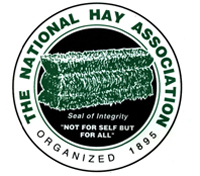Sun Cured Alfalfa
Please contact Al Dahra ACX to place orders. Email
USA Production
| Grade | Supreme, Premium, Standard |
| Specifications | CP (16% to 21%+), NDF (30% to 45%), ADF (30% to 38%) |
| Packaging | Double Compressed Half-Cut Bale (30Kg), Double Compressed Full Bale (60Kg), Log Bale (100Kg), MACX Bale Sleeve (450Kg), Single Press |
| Shipping | USA - West Coast: 40' high cube or 40' standard sea container, bulk-loaded, or UNIPACX® |
Egypt Production
| Grade | Standard, Premium |
| Specifications | CP (17% to 20%), NDF (35% to 45%), ADF (28% to 32%) |
| Packaging | Double Compressed Bale (430Kg to 450Kg) |
| Shipping | 40' high cube or 40' standard sea container, break bulk |
South Africa Production
| Grade | Premium, Grade 1, Grade 2 |
| Specifications | CP (16% to 19%), NDF (42% to 45%), ADF (32% to 38%) |
| Packaging | Single Press High Density Bale (330Kg, 500Kg, and 700Kg) |
| Shipping | 40' high cube or 40' standard sea container |
More about Alfalfa
Medicago sativa
 Alfalfa is a perennial flowering plant in the pea family, cultivated as an important forage crop in many countries around the world. The English name alfalfa is widely used, particularly in North America. But in the UK, Australia, South Africa and New Zealand, the more commonly used name is lucerne. It superficially resembles clover, with clusters of small purple flowers followed by fruits spiraled in 2 to 3 turns containing 10-20 seeds.
Alfalfa is a perennial flowering plant in the pea family, cultivated as an important forage crop in many countries around the world. The English name alfalfa is widely used, particularly in North America. But in the UK, Australia, South Africa and New Zealand, the more commonly used name is lucerne. It superficially resembles clover, with clusters of small purple flowers followed by fruits spiraled in 2 to 3 turns containing 10-20 seeds.
Alfalfa is native to a warmer temperate climate such as that of Iran (where it is thought to have originated). It has been cultivated as livestock fodder since at least the era of the ancient Greeks and Romans.
Alfalfa is a perennial forage legume which normally lives 4-8 years, but can live more than twenty years depending on variety and climate. The plant grows to a height of up to 1 meter (3 ft), and has a deep root system, sometimes stretching more than 15 meters. This makes it very resilient, especially to droughts.
Alfalfa is a small seeded crop, and has a slowly growing seedling, but after several months of establishment, forms a tough 'crown' at the top of the root system. This crown contains many shoot buds that enables alfalfa to re-grow many times after being grazed or harvested.
This plant exhibits autotoxicity, which means it is difficult for alfalfa seed to grow in existing stands of alfalfa. Therefore, it is recommended that alfalfa fields be rotated with other species like corn or wheat before reseeding.















